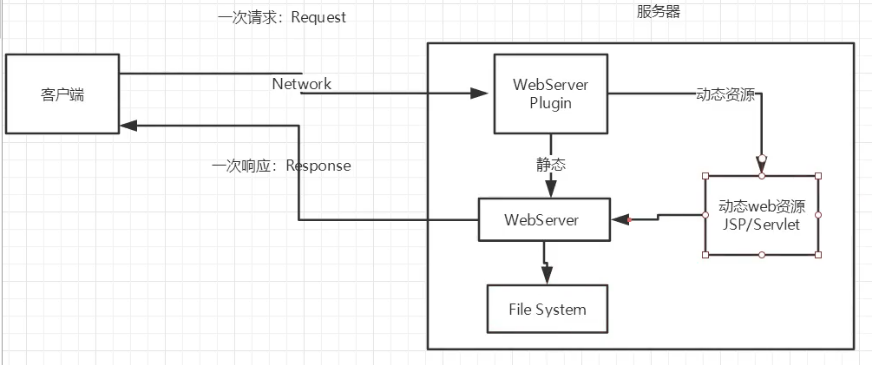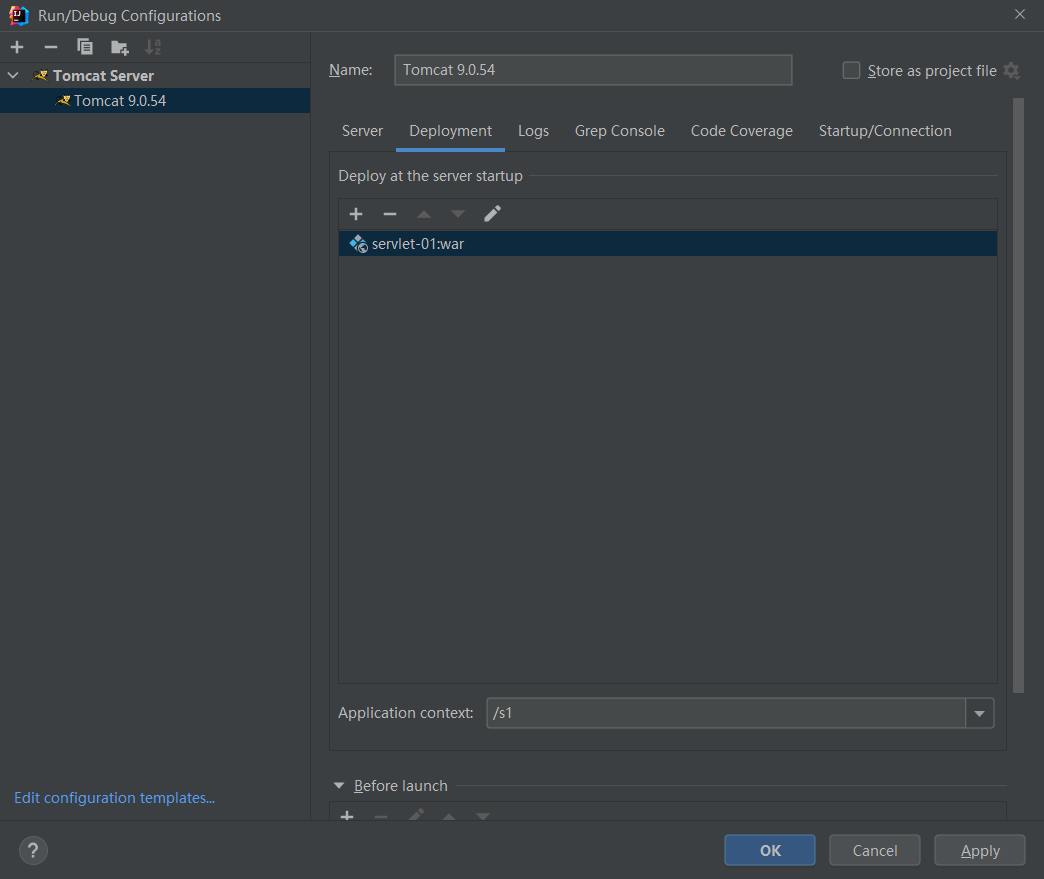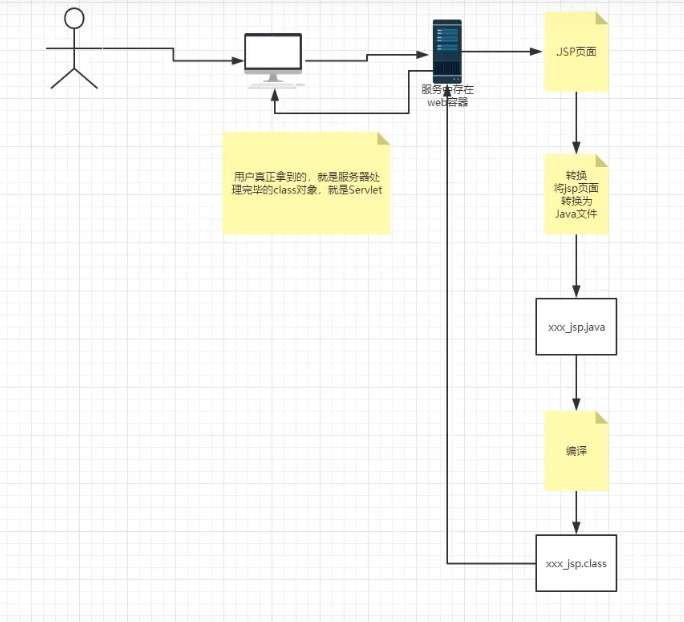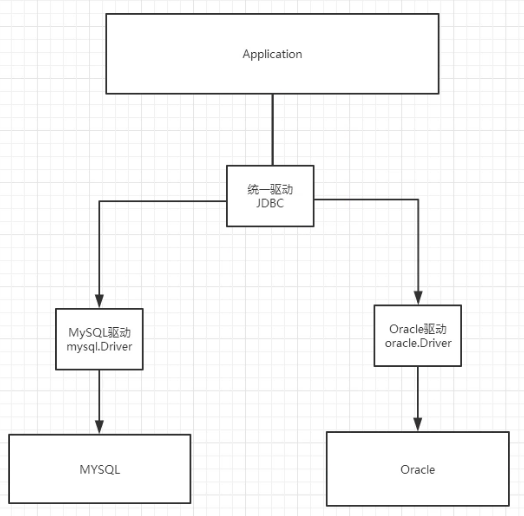JavaWeb.md 24 KB
JavaWeb
1、基本概念
1.1、前言
web开发:
- web,网页的意思,www.baidu.com
- 静态web
- html,css
- 提供给所有人看的数据始终不会发生变化!
- 动态web
- 淘宝,几乎是所有的网站;
- 提供给所有人看的数据始终会发生变化!
- 技术栈:Servlet/JSP,ASP,PHP
在Java中,动态web资源开发的技术统称为JavaWeb
1.2、web应用程序
web应用程序:可以提供浏览器访问的程序
- a.html,b.html.........多个web资源,可以被外界访问,对外界提供服务;
- 资源存在物理机上面
- URL
- 统一的web资源会被放在同一个文件夹下,web应用程序
- 一个web应用由多部分组成
- html,css,js
- jsp,servlet
- java程序
- jar包
- 配置文件(properties)
web应用程序编写完毕后,若想提供给外部访问;需要一个服务器来统一管理;
1.3、静态web
- .htm,.html,这些都是网页的后端,如果服务器上一直存在这些东西,我们就可以直接进行读取

- 静态web存在的缺点
- 微博页面无法动态更新,所有用户看到都是同一个页面
- 轮播图,点击特效:为动态
- javascript
- 无法与数据库交互
1.4、动态web
缺点
- 如果服务器的动态web资源出现了错误,我们需要重新编写我们的后台程序,重新发布;
- 停机维护
优点
- web页面可以动态更新
- 可以与数据库交互
2、web服务器
2.1、技术讲解
ASP
- 微软
- 在HTML中嵌入了VB脚本 PHP
- 开发速度很快,功能强大,跨平台,代码简单
- 无法承载大访问量的情况 JSP/Servlet:
- sun公司主推的B/S架构
- 基于Jva语言
- 可以承载三高问题带来的影响
2.2、web服务器
服务器是一种被动操作,用来处理用户的一些请求和用户一些相应信息; IIS Tomcat
3、Tomcat
- JAVA环境必须有
- 乱码:修改命令行编码为UTF-8
xml文件可以配置
- 端口号
- 主机名称
- 应用的存放位置
访问网站:
- 输入域名
- 检查本机hosts
- 访问DNS服务器
4、Servlet
4.1、Servlet简介
- Servlet就是sun公司开发动态web的一门技术
- sun在这些API中提供了一个接口叫做:Servlet
- 编写一个类实现这个接口
- 开发好的类部署到web服务器中
4.2、HelloServlet
- 构建一个主工程
关于maven父子工程的理解: 父项目中会有一个
<modules> <module>servlet01</module> </modules>子项目中会有一个
<parent></parent>父项目中的java子项目可以直接引用
编写一个servlet类,继承HttpServlet接口
public class HelloServlet extends HttpServlet { @Override protected void doGet(HttpServletRequest req, HttpServletResponse resp) throws ServletException, IOException { // 响应流 PrintWriter writer = resp.getWriter(); writer.print("Hello,Servlet"); } }- 为什么编写Servlet的映射
我们写的是JAVA程序,但是需要通过浏览器访问,而浏览器需要连接web服务器,所以我们需要在web服务中注册我们写的servlet,还需给他一个浏览器能够访问的路径
xml <servlet> <servlet-name>Hello</servlet-name> <servlet-class>com.servlet.HelloServlet</servlet-class> </servlet> <servlet-mapping> <servlet-name>Hello</servlet-name> <url-pattern>/hello</url-pattern> </servlet-mapping>
- 为什么编写Servlet的映射
我们写的是JAVA程序,但是需要通过浏览器访问,而浏览器需要连接web服务器,所以我们需要在web服务中注册我们写的servlet,还需给他一个浏览器能够访问的路径
4.3、Servlet原理
Servlet是由web服务器调用,web服务器在收到浏览器请求之后,会:

4.4、Mapping问题
一个Servlet可以指定一个映射路径
<servlet-mapping> <servlet-name>Hello</servlet-name> <url-pattern>/hello</url-pattern> </servlet-mapping>- 一个Servlet可以指定多个映射路径
xml <servlet-mapping> <servlet-name>Hello</servlet-name> <url-pattern>/hello1</url-pattern> </servlet-mapping> <servlet-mapping> <servlet-name>Hello</servlet-name> <url-pattern>/hello2</url-pattern> </servlet-mapping>
- 一个Servlet可以指定多个映射路径
一个Servlet可以指定通用映射路径------servlet优先级较高,会覆盖默认请求
<servlet-mapping> <servlet-name>Hello</servlet-name> <url-pattern>/hello/*</url-pattern> </servlet-mapping>- 指定一些后缀或者前缀
xml <servlet-mapping> <servlet-name>Hello</servlet-name> <!--*前面不能加项目映射路径--> <url-pattern>*.do</url-pattern> </servlet-mapping>
- 指定一些后缀或者前缀
默认请求路径------少用
<servlet-mapping> <servlet-name>Hello</servlet-name> <url-pattern>/*</url-pattern> </servlet-mapping>- 优先级问题 指定了固有的映射路径优先级最高,如果找不到就会走默认的处理请求。
4.5、ServletContext
web容器在启动的时候,他会为每个web程序都创建一个对应的ServletContext对象,他代表了当前的web应用;
4.5.1、共享数据
servlet中保存的数据,在另外的servlet可以拿到。
ServletContext servletContext = this.getServletContext(); servletContext.setAttribute("userName", userName); String userName = (String) servletContext.getAttribute("userName");
4.5.2、获取初始化参数
ServletContext servletContext = this.getServletContext();
String url = servletContext.getInitParameter("url");
resp.getWriter().print(url);
4.5.3、请求转发
// 该转发会带上d
this.getServletContext().getRequestDispatcher("/gp").forward(req,resp);
 通过这张图你就可以看到,转发是在服务器之间进行的,它的意思虽然我没有你想要的资源但是我可以帮你找到,
通过这张图你就可以看到,转发是在服务器之间进行的,它的意思虽然我没有你想要的资源但是我可以帮你找到,
重定向是告诉你,我Servlet1没有这个资源,但是我告诉你那里有,你自己通过浏览器去找,
4.5.4、读取资源文件
maven由于他的约定大于配置,我们写的配置文件,可能无法被导出或者生效,解决方法
<build>
<resources>
<resource>
<directory>src/main/resources</directory>
<excludes>
<exclude>**/*.properties</exclude>
<exclude>**/*.xml</exclude>
</excludes>
<filtering>false</filtering>
</resource>
<resource>
<directory>src/main/java</directory>
<includes>
<include>**/*.properties</include>
<include>**/*.xml</include>
</includes>
<filtering>false</filtering>
</resource>
</resources>
</build>
Properties 发现都被打包到了同一个路径下:classes,我们俗称为classpath 通过文件流读取。
4.6、HttpServletResponse
webn服务器接收到客户端的http请求,针对请求,分别创建一个代表请求的HttpServletRequest对象,代表响应的一个HttpServletResponse
- 如果要获取客户端请求过来的参数:HttpServletRequest
- 如果要找客户端响应的一些信息:HttpServletResponse
4.6.1、常用应用
- 输出信息
- 下载文件
- 获取下载文件的路径
- 下载的文件名
- 设置让浏览器能够支持我们需要的东西
- 获取下载文件的输入流
- 创建缓冲区
- 获取OutputStream对象
- 将OutputStream写入缓冲区
- 将缓冲区写入磁盘
- 验证码功能 验证怎么来的?
- 前端实现
- 后端实现,需要用到java的图片类,产生一个图片
- 重定向
 常见场景:
常见场景: 用户登录
// 需要设置改项目的路径 resp.setHeader("Location", "/r/image"); resp.setStatus(HttpServletResponse.SC_FOUND); resp.sendRedirect("/r/image");重定向和转发区别? 相同点:
- 界面都会实现改变 不同点:
- 一个是web服务器
- 一个是浏览器
- 转发会加上项目路径,而重定向不会
- 重定向:302
- 转发:307
4.7、HttpServletRequest
HttpServletRequest代表客户端的请求,用户通过http服务请求都被封装到Request下面。
- 获取前端请求的参数
- 转发请求
java req.getRequestDispatcher("/image").forward(req,resp);
5、Cookie、Session
5.1、会话
会话:用户打开一个浏览器,点击了很多超链接,访问了多个web资源,关闭浏览器,这个过程称之为会话。 有状态会话:保存上次会话的状态 怎么证明自己是西电学生?
- 发票
- 登记 一个网站,怎么证明你来过? 客户端 服务端
- 服务端给客户端一个信件,客户端下次访问服务端带上信件就可以了:cookie
- 服务器登记你来过了,下次你来的时候我来匹配你:session
5.2、保存会话的两种技术
cookie
- 客户端技术(响应,请求)
session
- 服务器技术,利用这个技术,可以保存用户的会话信息!我们可以把信息或者数据放入session
常见场景:网站登录之后,下次不需要登录
5.3、cookie
- 从请求中拿到cookie信息
服务器响应给客户端cookie
Cookie[] cookies = req.getCookies();- 一般会保存在本地目录下
一个网站cookie是否存在上限
- 一个cookie只能保存一个信息
- 一个web站点可以给浏览器发送多个cookie,最多存放20个cookie
- 300个浏览器上限
- cookie大小有限制4kb
删除cookie;
- 不设置有效期,关闭浏览器,自动失效;
- 有效期设置为0,自动消失
5.4、Session(重点)
什么是session:
- 服务器会给每一个用户(浏览器创建一个)session对象
- 一个session独占一个浏览器,只要浏览器没有关闭,这个session就存在
- 用户登录之后,整个网站都可以访问!保存用户的信息;保存购物车的信息
session和cookie的区别:
- cookie是浏览器保存(可以保存多个)
- session是用户独占,服务器端保存(保存重要信息,减少服务器资源浪费)
- session对象是由服务器创建
session使用场景:
- 保存一个登录用户的信息
- 购物车信息:
- 整个网站中经常会使用的数据
什么时候会被销毁? 话题:当浏览器关闭后,Session就销毁了吗? 答案:存在于浏览器上的唯一标识符JSESSIONID(sessionid)消失了,但是服务器中存放的sessionid并没有立马销毁。 分析:我们知道Session是JSP的九大内置对象(也叫隐含对象)中的一个,它的作用是可以保存当前用户的状态信息,初学它的时候,认为Session的生命周期是从打开一个浏览器窗口发送请求到关闭浏览器窗口,但其实这种说法是不正确的!当一个Session开始时,Servlet容器会创建一个HttpSession对象,那么在HttpSession对象中,可以存放用户状态的信息,Servlet容器为HttpSession对象分配一个唯一标识符即Sessionid,Servlet容器把Sessionid作为一种Cookie保存在客户端的浏览器 中用户每次发出Http请求时,Servlet容器会从HttpServletRequest对象中取出Sessionid,然后根据这个Sessionid找到相应的HttpSession对象,从而获取用户的状态信息。
其实让Session结束生命周期,有以下两种办法:
- 一个是Session.invalidate()方法,不过这个方法在实际的开发中,并不推荐,可能在强制注销用户的时候会使用;
- 一个是当前用户和服务器的交互时间超过默认时间后,Session会失效。
6、JSP
6.1、什么是JSP?
java server pages:java服务器端界面,也和servlet一样,用于动态web技术 最大的特点:
- 写JSP就像写HTML
- 区别
- HTML只给用户提供静态数据
- JSP页面中可以嵌入JAVA代码,为用户提供动态数据
6.2、JSP原理
代码层面没有任何问题
服务器内部工作
tomcat中有一个work目录
IDEA中使用tomcat开发会在idea中生成一个work目录
浏览器向服务端发送请求,不管访问什么请求,其实都是在访问servlet
JSP最终会转换为java类
JSP本质还是一个servlet
- 判断请求
- 内置一些对象
java final javax.servlet.jsp.PageContext pageContext; // 页面上下文 javax.servlet.http.HttpSession session = null; // session final javax.servlet.ServletContext application; // applicationcontext final javax.servlet.ServletConfig config; //配置 javax.servlet.jsp.JspWriter out = null; // out final java.lang.Object page = this; // page当前页
输出页面前增加的代码
response.setContentType("text/html"); // 响应类型 pageContext = _jspxFactory.getPageContext(this, request, response, null, true, 8192, true); _jspx_page_context = pageContext; application = pageContext.getServletContext(); config = pageContext.getServletConfig(); session = pageContext.getSession(); out = pageContext.getOut(); _jspx_out = out;- 以上这些对象我们在JSP页面中直接使用
- 在JSP页面中:
如果是JAVA代码就会被原封不动的输出
如果是HTML代码就会被转换为out.write("
")这样的格式渲染到前端6.3、JSP基本语法
任何语言都有自己的语法,JPS作为java的一种应用,它拥有自己的扩充语法(了解即可),并且支持所有的java语法
- JSP表达式
<%--JSP表达式 作用:用来将程序的输出到客户端 <%= 变量或者表达式%> --%> <%= new java.util.Date()%>- 以上这些对象我们在JSP页面中直接使用
JSP脚本片段
<%
int sum = 0;
for (int i = 0; i < 100; i++) {
sum += i;
}
out.println("<h1>Sum=" + sum + "</h1>");
%>
<%--JSP脚本片段--%>
<%
int sum = 0;
for (int i = 0; i < 100; i++) {
sum += i;
}
out.println("<h1>Sum=" + sum + "</h1>");
%>
<%
for (int i = 0; i < 5; i++) {
%>
<h1>Hello,World <%=i%></h1>
<%
}
%>
- jsp声明:会被编译到JSP生产JAVA类中!其他的,就会被生产到_jspservice方法中!
<%!
static {
System.out.println("Loading Servlet!");
}
private int g = 0;
public void test() {
System.out.println("in test method");
}
%>
- jsp的注释无法显示在html中
6.4、JSP指令
<%@page%>
<%--g--%>
<%@include file=""%>
这个与上面的区别:下面的本质还是三个页面而上面是三个部分拼接成一个
jsp:include page="index.jsp"/
6.5、9大内置对象
- Pagecontext 存东西
- Request 存东西
- Response
- Session 存东西
- Application 存东西
- Config
- out
- page
- Exception
// 保存的数据只在一个页面有效
pageContext.setAttribute("name1", "1");
// 保存的数据只在一次请求中有效,请求转发(重定向无效)会携带这个数据
request.setAttribute("name2", "2");
// 保存的数据只在一次会话有效
session.setAttribute("name3", "3");
// 保存的数据只在服务器中有效,从打开服务器到关闭服务器
application.setAttribute("name4","4");
6.6、JSP标签、JSTL标签、EL表达式
<!--JSTL表达式依赖-->
<dependency>
<groupId>javax.servlet.jsp.jstl</groupId>
<artifactId>jstl-api</artifactId>
<version>1.2</version>
</dependency>
<!--standard标签库-->
<dependency>
<groupId>taglibs</groupId>
<artifactId>standard</artifactId>
<version>1.1.2</version>
</dependency>
EL表达式:${}
- 获取数据
- 执行运算
- 获取web开发的常用对象
JSP标签
<jsp:include page="index.jsp"/>
<%--转发--%>
<jsp:forward page="/jsptag2.jsp">
<jsp:param name="a" value="a"/>
<jsp:param name="b" value="b"/>
</jsp:forward>
JSTL标签
JSTL标签库的使用就是为了弥补HTML标签的不足;他自定义许多标签,可以供我们使用,标签的功能和java代码一样!
- 核心标签(要求掌握部分)
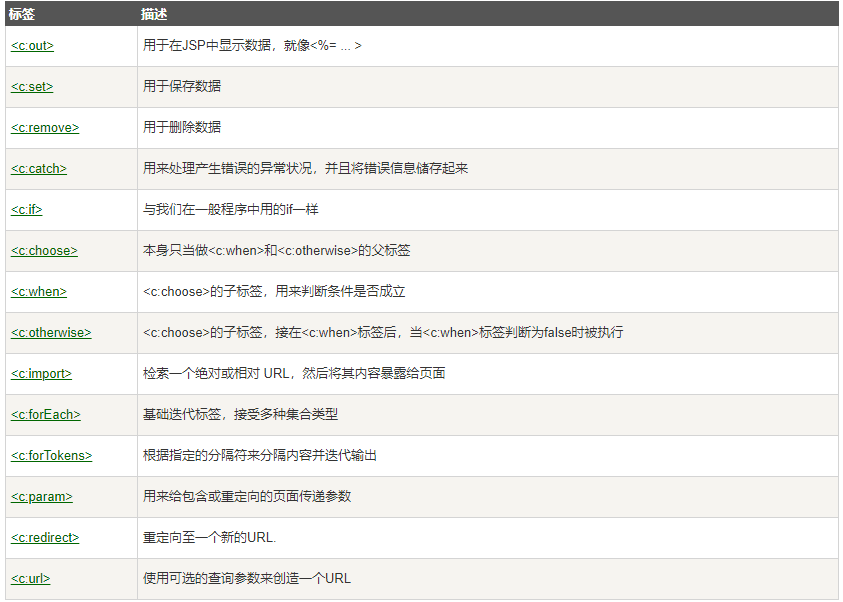
- 格式化标签
- SQL 标签
- XML 标签
- ```jsp <%@ taglib prefix="c" uri="http://java.sun.com/jsp/jstl/core" %> /c:if
## 7、JavaBean
***
实体类
JavaBean有特点的写法:
* 必须定义无参构造
* 属性必须私有化
* 必须有对应的get/set方法
一般用来和数据库字段做映射ORM;
ORM:对象关系映射
* 表->类
* 字段->属性
* 行记录->对象
People表
| id | name | age | address |
| ---- | ---- | ---- | ------- |
| 1 | tom | 10 | 西安 |
| 2 | lin | 19 | 西安 |
| 3 | pet | 13 | 西安 |
```java
public class People {
private int id;
private String name;
private int age;
private String address;
}
<jsp:useBean id="people" class="com.entity.People" scope="page"/>
<jsp:setProperty name="people" property="address" value="西安"/>
<jsp:setProperty name="people" property="id" value="1"/>
<jsp:setProperty name="people" property="age" value="3"/>
<jsp:setProperty name="people" property="name" value="tom"/>
<jsp:getProperty name="people" property="address"/>
<jsp:getProperty name="people" property="id"/>
<jsp:getProperty name="people" property="age"/>
<jsp:getProperty name="people" property="name"/>
8、MVC三次架构
什么是MVC:model view controller 模型、 视图、 控制器
8.1、早些年
servlet--CRUD--->数据库
弊端:程序十分臃肿,不利于维护
servlet的代码中:处理请求、响应、视图跳转、处理JDBC、处理业务代码、处理逻辑代码
8.2、MVC三层架构
Model
- 业务处理:业务逻辑(Service)
- 数据持久层:CRUD(Dao)
View
- 展示数据
- 提供链接发起Servlet请求(a,form, img)
Controller(Servlet)
- 接受用户的请求:req,参数和session信息
- 交给业务层处理响应的代码
控制视图的跳转
登录----》接受用户的请求---》处理用户的请求(获取参数:username,password)----》交给业务层处理登录业务(判断用户名密码是否正确:事务)-----》Dao层查询用户名和密码是否正确----》数据库
9、Filter(重点)
Filter:过滤器,用来过滤网站的数据;
Filter开发步骤:
- 导包
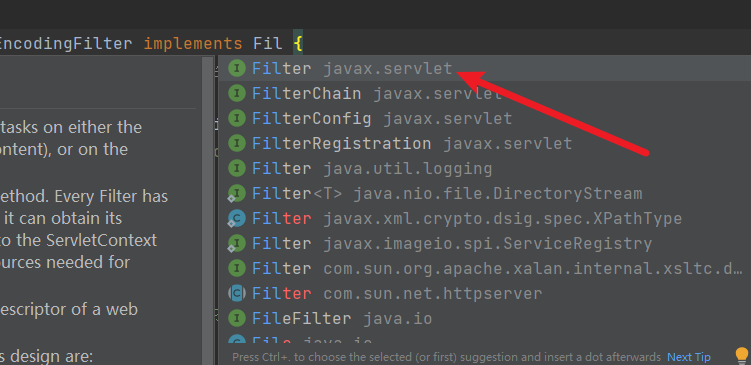
编写过滤器 ```java public class CharacterEncodingFilter implements Filter { // 初始化:web服务器启动就已经初始化了,随时等待监听 @Override public void init(FilterConfig filterConfig) throws ServletException {
System.out.println("init CharacterEncodingFilter");}
// chain:链
/**
- 1.过滤器中的所有代码,在过滤特定请求的时候都会执行
2.必须要让过滤器继续通行 */ @Override public void doFilter(ServletRequest request, ServletResponse response, FilterChain chain) throws IOException, ServletException { request.setCharacterEncoding("utf-8"); response.setCharacterEncoding("utf-8"); response.setContentType("text/html; charset=UTF-8");
System.out.println("CharacterEncodingFilter执行前"); // 让我们的请求继续走,如果不写,程序在这里就被拦截 chain.doFilter(request,response); System.out.println("CharacterEncodingFilter执行后"); }
// 销毁:web服务器关闭的时候,过滤器会销毁 @Override public void destroy() {
System.out.println("destroy CharacterEncodingFilter");} }
3. 在web.xml中配置 ```xml <filter> <filter-name>CharacterEncodingFilter</filter-name> <filter-class>com.filter.CharacterEncodingFilter</filter-class> </filter> <filter-mapping> <filter-name>CharacterEncodingFilter</filter-name> <!--只要是/servlet的任何请求,都会经过这个过滤器--> <url-pattern>/servlet/*</url-pattern> </filter-mapping>
10、监听器
实现一个监听器的接口;(有n种)
重写方法
public class OnlineCountListener implements HttpSessionListener { // 创建session监听,一旦创建一个session就会触发这个事件 @Override public void sessionCreated(HttpSessionEvent se) { ServletContext context = se.getSession().getServletContext(); Integer onlineCount = (Integer) context.getAttribute("OnlineCount"); if (onlineCount == null) { onlineCount = new Integer(1); } else { int value = onlineCount.intValue(); onlineCount = new Integer(value + 1); } context.setAttribute("OnlineCount", onlineCount); } // 销毁session监听,一旦销毁一个session就会触发这个事件 @Override public void sessionDestroyed(HttpSessionEvent se) { ServletContext context = se.getSession().getServletContext(); Integer onlineCount = (Integer) context.getAttribute("OnlineCount"); if (onlineCount == null) { onlineCount = new Integer(0); } else { int value = onlineCount.intValue(); onlineCount = new Integer(value - 1); } context.setAttribute("OnlineCount", onlineCount); } }- 配置web.xml
xml <!--注册监听器--> <listener> <listener-class>com.listener.OnlineCountListener</listener-class> </listener>
- 配置web.xml
11、过滤器监听器常见应用
用户登陆之后才能进入主页!用户注销就不能进入主页!
@Override
public void doFilter(ServletRequest request, ServletResponse response, FilterChain chain) throws IOException, ServletException {
// 转换过来才能过去session
HttpServletRequest httpServletRequest = (HttpServletRequest) request;
HttpServletResponse httpServletResponse = (HttpServletResponse) response;
if (httpServletRequest.getSession().getAttribute("USER_SESSION") == null) {
httpServletResponse.sendRedirect("/f/error.jsp");
}
chain.doFilter(request,response);
}
12、JDBC
什么是JDBC:Java连接数据库
导入驱动
<!--连接数据库--> <dependency> <groupId>mysql</groupId> <artifactId>mysql-connector-java</artifactId> <version>8.0.19</version> </dependency>java语句
String url = "jdbc:mysql://localhost:3306/jdbc?useUnicode=true&characterEncoding=utf-8"; String username = "root"; String password = "123456"; // 加载驱动 Class.forName("com.mysql.jdbc.Driver"); // 连接数据库,代表数据库 Connection connection = DriverManager.getConnection(url, username, password); // 想数据库发送SQL的对象Statement:CRUD Statement statement = connection.createStatement(); // 编写SQL String sql = "select * from users"; // 执行SQL,返回结果集 ResultSet resultSet = statement.executeQuery(sql); while (resultSet.next()) { System.out.println("id" + resultSet.getObject("id")); } resultSet.close(); connection.close(); statement.close();
事务 要么都成功,要么都失败! ACID原则:保证数据的安全
开启事务
事务提交 commit
事务回滚 rollback
关闭事务
